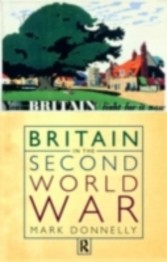
Britain in the Second World War

von: Mark Donnelly
Routledge, 1999
ISBN: 9780203980835
Sprache: Englisch
139 Seiten, Download: 927 KB
Format: PDF
Chapter 3
The wartime economy (p. 53-54)
War tested Britain’s ability to mobilise its economic resources for a long, draining and expensive national effort. The Emergency Powers (Defence) Act of August 1939 was the first in a series of measures which enabled the government to intervene in the economy on an unprecedented scale. As the war progressed an extensive network of economic controls was established, covering almost every aspect of supply, production and trade. The machinery of government was redesigned to administer these controls (Hancock and Gowing 1949; Chester 1951) and some fifty economists were recruited into Whitehall to act as advisers (Cairncross 1995:20). In the ‘phoney war’ there had been some reluctance to exploit these powers to the full: Chamberlain’s government was ideologically opposed to extensive state intervention in the economy; it feared that a rapid mobilisation of resources for war production would have damaging economic consequences, and mutual suspicion between government and trade unions meant that imaginative manpower policies were rejected as unlikely to work. Therefore, although there was some departure from pre-war orthodoxy before May 1940, the most significant developments in the mobilisation of the war economy came after Hitler’s attack on the west and the setting up of Churchill’s wartime coalition. This chapter will assess the main measures used to gear the economy for war, the performance of Britain’s wartime economic effort and the legacy of the conflict for the post-war economy.
Organising the war economy
The coalition government had a more active approach to the planned use of physical resources than its predecessor. The most important of these resources was manpower, control of which was the responsibility of the coalition’s Minister of Labour and National Service, Ernest Bevin. His task was to distribute labour between competing needs: to balance the demands of the armed forces, the requirements of war production and the needs of civilian industry and services. By the end of 1942 the principle of manpower budgeting had been formalised and the Ministry of Labour and National Service was recognised as the most important wartime department of state. In theory Bevin had massive powers over labour from the outset: Regulation 58A of the new Emergency Powers (Defence) Act of May 1940 gave him the authority to require individuals to register for war work and then to direct them to work under terms and conditions laid down by the Ministry. These regulations were extended over time and by the middle of the war all adults up to the age of 50 had been registered. At the peak of labour mobilisation approximately 10 million persons were either in active service or employed in the munitions industries. Also, some 8 million employees were affected by Essential Work Orders, which had been introduced in 1941 to keep workers in place in jobs which were vital to the war effort—for example, in engineering, coal, shipbuilding, iron and steel—by restricting the rights of employees to resign from a job and the rights of employers to dismiss workers (Aldcroft 1986:166). In practice, however, Bevin relied as far as possible on the voluntary principle, partly because of his background in the trade union movement, but also to avoid a repeat of the industrial unrest which broke out in the first world war. He consulted both the TUG and employers’ federations over policy and used his powers to direct labour sparingly. In fact, only some 250,000 men and 90,000 women were directed into wartime industrial work which they had not chosen (Middlemas 1986:31).
Bevin’s desire to win consent from all sides was reflected in the formal arrangements he made for consultation. The main agreements about labour matters were reached on the Joint Consultative Committee, a body with equal representation of management and unions, whose twice monthly meetings were usually chaired by Bevin (Middlemas 1986:21). The inclusion of the trade unions in an official framework signalled an important change from the time when relations between government and the TUG were at a low point under Chamberlain. It recognised that the support of the unions was vital if labour was to be transferred from civilian production to essential war industries without widespread unrest.






